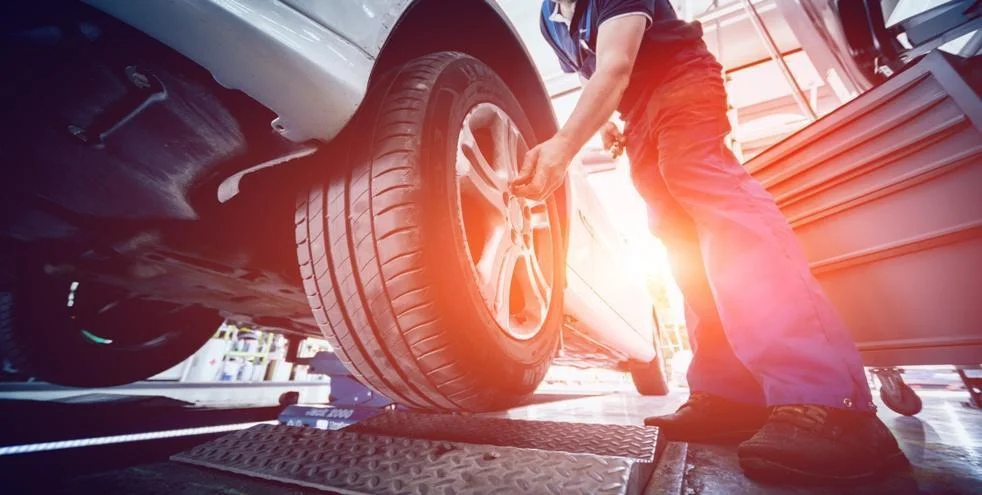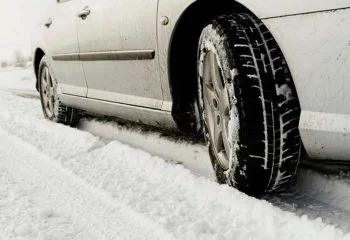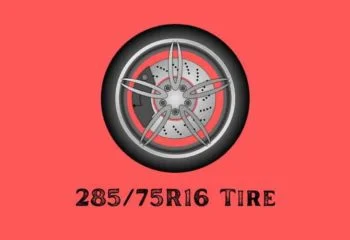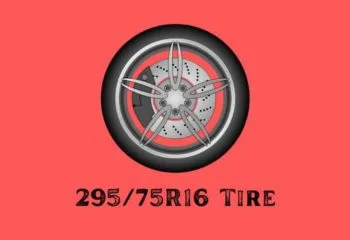If your car feels like it’s shaking more than normal, or if you’re experiencing problems with steering, it might be time to have the tires checked. It might be because one of your tires is out of balance
This can be a dangerous situation, so it’s important to know how to tell which tire is out of balance and how to fix it.
In this blog post, we’ll go over the symptoms of a tire that’s out of balance and how to fix it. We’ll also offer a few tips on how to avoid this problem altogether. Keep reading to learn more!
What's in this post?
What is a tire out of balance and why is it important to fix it
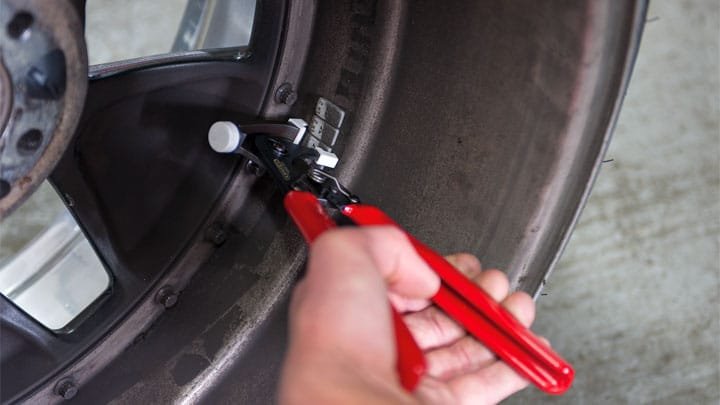
A tire that is out of balance is a tire that does not rotate evenly as it spins. This can happen for a number of reasons, such as an uneven tread or a build-up of foreign objects on one side of the tire.
Regardless of the cause, an out-of-balance tire will create a vibration as it rotates, which can be extremely annoying for drivers. More importantly, an out-of-balance tire will also put extra stress on other parts of the vehicle, such as the suspension and wheels.
Over time, this can lead to expensive repairs. For these reasons, it is important to have a tire that is properly balanced. A qualified mechanic can quickly and easily fix an out-of-balance tire, ensuring a smoother ride for you and your vehicle.
5 symptoms that tell your tire out of balance

There are a few symptoms that can indicate that one of your tires is out of balance, such as:
- Vibrations
- Problems with steering
- Uneven Tire Wear
- Bad Fuel Economy
- Bad Shocks and Bearings
Let’s go detail each one.
Vibrations
The most common symptom of an out-of-balance tire is a vibration. This can be felt in the steering wheel, seat, or floorboard of the vehicle. The severity of the vibration will depend on how far out of balance the tire is.
A small imbalance may not be noticeable, while a large imbalance can be quite bothersome. If you notice a vibration when driving, it’s important to have your tires checked as soon as possible.
This vibration can be caused by an uneven distribution of weight around the tire. Often, this is the result of the tire wearing down in one spot more than others.
Tire balancing is a process that helps to redistribute the weight around the tire so that it wears evenly.
Problems with steering
When a tire is out of balance, it can cause problems with steering. The weight of the tire is not evenly distributed, which can cause the tire to pull to one side. This can make it difficult to keep the vehicle going straight, especially at higher speeds.
It can also cause premature wear on the tires and suspension components.
If you notice that your car is veering to one side or the other, it’s important to have the tires checked. This is especially true if the problem seems to be getting worse over time.
Uneven Tire Wear
Another symptom of an out-of-balance tire is uneven tire wear. When your tires are out of balance it causes them to spin unevenly as you’re driving down the road and that in turn will cause the tread on your tires to wear down unevenly as well.
This can be a big problem because it not only causes your tires to wear down quicker but it can also be dangerous. If the tread on your tires wears down too much it can cause a blow out which could lead to an accident.
Bad Fuel Economy
If you notice that your vehicle’s fuel economy has gone down, it could be because one of your tires is out of balance. When tires are unbalanced, they create a drag on the engine as they spin. This extra drag can cause the engine to work harder, which in turn can lead to reduced fuel economy.
If you’ve noticed that your fuel economy has gone down and you can’t figure out why, it’s worth having your tires checked. An out-of-balance tire could be the culprit.
Bad Shocks and Bearings
Another symptom of an out-of-balance tire is bad shocks and bearings. When a tire is unbalanced, it puts extra stress on these components as they work to keep the tire spinning smoothly.
Over time, this extra stress can cause the shocks and bearings to wear out prematurely. If you notice that your shocks or bearings are going bad, it’s important to have your tires checked as soon as possible.
If you notice any of these symptoms, it’s time to have your tires checked. A qualified mechanic will be able to tell which tire is out of balance and fix the problem quickly and easily.
How to tell which tire is out of balance
Checking which car’s tire is out of balance is a very important safety step. Most carmakers recommend balancing tires whenever you replace one. There are a few different ways that you can go about checking this.
Many service centers will check tire balance for free and let you know if any of your tires need to be rebalanced. Here’s how to check tire balance yourself:
- Park your car on a level surface and set the emergency brake.
- Place a jack under the car and raise it until the tire you want to check is about 6 inches off the ground.
- Spin the tire slowly and look for which tires are wobble. If you see any wobbling, that indicates that the tire is out of balance.
- To confirm that the wobbling is due to an imbalance, remove the wheel and spin it on its own. If it still wobbles, then you know the tire is out of balance and needs to be rebalanced.
- Repeat this process for all of the tires on your car.
- Lower the car back down to the ground and take it to a service center so they can rebalance the tire.
Tire balancing is an important part of maintaining your car and keeping it running smoothly. By checking tire balance regularly, you can extend the life of your tires and avoid potential damage to your suspension.
What cause unbalance tires?
There can be many causes of unbalanced tires. A car’s suspension system is designed to keep the car’s weight evenly distributed, but over time, this distribution can become uneven.
If a car hits a curb or pothole, the alignment of the suspension can also be thrown off, causing the tires to become unbalanced. Unbalanced tires can also be caused by simply wearing down over time.
As the tread on the tires becomes thinner, the weight distribution changes and the tires can become unbalanced. Ultimately, any factor that throws off the suspension or changes the weight distribution of the car can cause unbalanced tires.
Useful read: Who Makes Mastercraft Tires? Are They Good?
How to balancing tire yourself
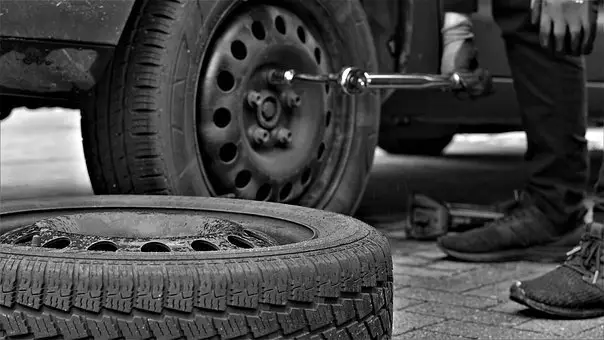
If you have an unbalanced tire, the best way to fix it is to take it to a service center and have them rebalance it. This is a simple process that most service centers can do quickly and easily.
If you don’t have time to take your car to a service center, you can try balancing the tires yourself. To do this, you’ll need a jack and a lug wrench.
- First, park your car on a level surface and set the emergency brake. Place the jack under the car and raise it until the tire you want to balance is about 6 inches off the ground.
- Next, remove the wheel and place it on a flat surface. Find the heaviest point on the tire and mark it with a pencil. This is where you’ll need to add weight.
- To add weight, place a penny at the heaviest point on the tire and tape it in place. Repeat this process until the tire is balanced.
- Once the tire is balanced, replace the wheel and lower the car back down to the ground. Test drive the car to see if the issue has been resolved.
If you notice any of these symptoms, it’s time to have your tires checked by a qualified mechanic who can tell which tire is out of balance and fix the problem quickly and easily.
Balancing vs alignment
Balancing and alignment are two important aspects of vehicle maintenance. Balancing refers to the process of ensuring that the weight of the tires and wheels is evenly distributed.
This is important because it helps to prevent problems like vibration and premature tire wear.
Alignment, on the other hand, refers to the adjustment of the suspension components so that the wheels are pointing in the correct direction.
This is important for maintaining handling and preventing uneven tire wear. Both balancing and alignment are essential for ensuring safe and reliable operation of a vehicle.
While both balancing and alignment are important, they are not the same thing. Balancing is typically done more often than alignment, and it is usually less expensive.
Useful tips: How to Fix a Slow Leak in a Tire?
How much will it cost to have a professional balance your tires
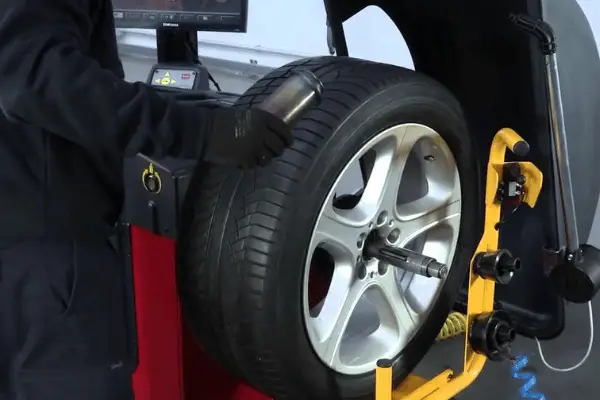
If you’re noticing that your car isn’t handling as smoothly as it used to, it might be time to have your tires balanced. This is a relatively simple and inexpensive procedure that can make a big difference in the way your car drives.
Most tire shops will charge between $25 and $30 per tire, so it’s a good idea to have all four tires done at the same time. While you’re at it, you might also want to have your tires rotated to help even out the wear and tear.
How to prevent unbalance tire
The best way to prevent unbalance tires is to have your suspension system checked and adjusted on a regular basis. This will help to keep the car’s weight evenly distributed and prevent the alignment from becoming thrown off.
In addition, be sure to avoid hitting curbs or potholes whenever possible. If you do hit something, take your car to a service center so that they can check the alignment and make any necessary adjustments.
Finally, be sure to have your tires rotated on a regular basis. This will help to even out the wear and tear and prevent unbalanced tires.
FAQs
Is it OK to drive with unbalanced tires?
The simple answer is no, driving with unbalanced tires is not advisable and can ultimately lead to costly repairs. When a tire is unbalanced, it means that the weight of the tire is not evenly distributed.
This often occurs when a tire is replaced or repaired, as the weight of the new tire or inner tube will be different from the old one.
As a result, the tire will spin unevenly, which puts stress on the suspension and can cause the car to vibrate. In addition, unbalanced tires will wear down more quickly, as they are constantly being forced to compensate for the imbalance. Ultimately, driving with unbalanced tires is not worth the risk and should be avoided.
Can Unbalanced tires cause death wobble?
Unbalanced tires can cause death wobble, which is a condition where the front end of a vehicle begins to shake uncontrollably.
This can be caused by a number of factors, including uneven tread wear, mismatched tires, or even incorrect tire pressure.
While death wobble is usually not deadly, it can be extremely dangerous and can cause accidents. If you suspect that your tires are unbalanced, have them checked by a professional as soon as possible.
Why does my car wobble when I hit a bump?
When you hit a bump in the road, your car’s suspension system is designed to absorb the impact and protect you from feeling the jolt.
However, if your suspension is damaged or worn out, it can cause your car to wobble. This can be extremely dangerous, as it can make it difficult to control your car.
If you notice that your car is wobbling, it’s important to have it checked out by a qualified mechanic as soon as possible. In some cases, simply replacing a worn out part can solve the problem.
However, if the damage is more severe, you may need to have your suspension system entirely rebuilt. Either way, it’s important to get the problem fixed before hitting the road again.
What is a death wobble?
A death wobble is a dangerous condition that can occur when driving at high speeds. The cause of the death wobble is typically a loose or worn component in the suspension system, but it can also be caused by improper tire balancing or alignment. In some cases, it may even be caused by hitting a large pothole or other object.
The death wobble can be very dangerous and can even cause the vehicle to flip over. It is important to be aware of the danger of the death wobble and to take steps to avoid it.
One way to avoid the death wobble is to keep your vehicle well-maintained. This means regularly checking the alignment of your wheels and making sure that they are properly inflated. (See Over Inflated Tires Symptoms and How is It Bad to Your Car)
If you do experience a death wobble, do not Panic. Instead, slowly reduce your speed and pull over to the side of the road. Once you have stopped, check your tires and Wheels for any damage.
If everything looks okay, you can continue on your journey. Just be sure to drive carefully and keep an eye out for any potential problems.
Do rear car wheels need balancing?
Like any other rotating object, wheels and tires need to be balanced. This means that the weight of the wheel and tire is evenly distributed around the axle. If the weight is unevenly distributed, it can cause the wheel to wobble or shake.
While this may not seem like a big deal, it can actually lead to some serious problems.
It can cause premature wear on your tires and suspension components. Also, it can negatively affect your gas mileage and make your car less safe to drive.
So, if you’re noticing that your car isn’t riding as smoothly as it used to, or if your tires are wearing unevenly, it’s a good idea to have your wheels balanced.
Does wheel balance affect steering?
The balance of your wheels is important for several reasons.
- It helps to ensure that your vehicle travels in a straight line.
- It prevents vibrations which can cause premature wear and tear on your tires and suspension.
- It makes steering easier and more precise. fourth, it helps to improve fuel economy.
There are two types of wheel balance: static and dynamic. Static balance occurs when the weight of the wheel is evenly distributed around the axle.
Dynamic balance occurs when the weight of the wheel is balanced around the point where it contacts the ground. Most vehicles have static front wheels and dynamic rear wheels.
Dynamic balancing is more important for steering than static balancing. This is because the front wheels are responsible for guiding the vehicle, while the rear wheels follow along behind.
If the front wheels are out of balance, it will be harder to steer in a straight line. If the rear wheels are out of balance, it can cause a “swaying” feeling when you turn corners. Either way, it’s important to make sure that all four of your wheels are properly balanced.
Do unbalanced tires affect alignment?
If a tire is unbalanced, it means that the weight of the tire is not evenly distributed. This can cause several problems.
- It will cause the vehicle to vibrate. This can be extremely uncomfortable for passengers and can cause damage to the suspension system over time.
- Unbalanced tires will wear out more quickly than balanced tires. This means that they will need to be replaced more frequently, which can be costly.
- Lastly, unbalanced tires can affect the alignment of the vehicle. When the tires are not aligned properly, it can cause the vehicle to pull to one side or the other, making it difficult to drive.
For these reasons, it is important to make sure that all tires are properly balanced.
How long does it take to balance tires?
While the exact time it takes to balance tires can vary depending on the type of tire and the size of the vehicle, the process generally takes between 45 minutes and 2 hours.
Do I need alignment after balancing?
After having your tires balanced, you may be wondering if you need to have your alignment checked as well. The answer is: it depends. If your tires were significantly out of balance, then it’s possible that the alignment was affected.
However, if the imbalance was minor, then your alignment probably isn’t off. Ultimately, the best way to know for sure is to have a professional take a look.
They’ll be able to tell you whether or not you need an alignment based on the condition of your tires and suspension components. So if you’re unsure, it’s always best to err on the side of caution and get a professional opinion.
How often should you balance your tires?
Most carmakers recommend that tires be balanced every 4,000 to 6,000 miles. That said, there are a number of factors that can affect how often tires need to be balanced.
For example, if you frequently drive on rough roads, your tires may need to be balanced more often. Likewise, if you notice that your car is vibrating at high speeds, it’s a good idea to have your tires balanced as soon as possible.
The best way to determine how often your tires need to be balanced is to consult your owner’s manual or talk to a qualified automotive technician.
Why does my car shake when I go 70 mph?
Many drivers have experienced their car shaking or vibrating at high speeds. While this can be alarming, it is usually not cause for concern. There are several reasons why your car might shake when you reach highway speeds. One possibility is that the tires are unbalanced.
This can happen if you hit a curb or pothole, or if the tires wear unevenly. Another possibility is that the wheels are out of alignment. This can also be caused by hitting a curb or pothole, and it can lead to uneven tire wear.
If your car is shaking or vibrating at high speeds, the best course of action is to have the tires checked and the alignment checked by a certified mechanic. With proper maintenance, you can keep your car running smoothly for years to come.
Final thoughts
Balancing your tires is an important part of keeping your car in good condition. If you’re experiencing any of the symptoms we’ve mentioned, it’s time to have your tires checked. So how to tell which tire is out of balance?
A quick and easy way to do this is to drive onto one of those big scales at a gas station – if one or more tires seems heavier than the others, that’s an indication that they need balancing.
Not only will this make your car ride smoother, it’ll also help extend the life of your tires by preventing excessive wear and tear.
A tire that is out of balance can cause a number of problems for your car, from decreased fuel efficiency to premature wear and tear on the tires. It can also be dangerous, so it’s important to take care of the problem as soon as you can.
We hope this blog post has been helpful. If you have any questions, feel free to reach out to us. We’re always happy to help!

